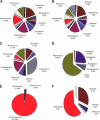Clostridium difficile carriage in elderly subjects and associated changes in the intestinal microbiota
- PMID: 22162545
- PMCID: PMC3295116
- DOI: 10.1128/JCM.05176-11
Clostridium difficile carriage in elderly subjects and associated changes in the intestinal microbiota
Abstract
Clostridium difficile is an important nosocomial pathogen associated particularly with diarrheal disease in elderly individuals in hospitals and long-term care facilities. We examined the carriage rate of Clostridium difficile by culture as a function of fecal microbiota composition in elderly subjects recruited from the community, including outpatient, short-term respite, and long-term hospital stay subjects. The carriage rate ranged from 1.6% (n = 123) for subjects in the community, to 9.5% (n = 43) in outpatient settings, and increasing to 21% (n = 151) for patients in short- or long-term care in hospital. The dominant 072 ribotype was carried by 43% (12/28) of subjects, while the hypervirulent strain R027 (B1/NAP1/027) was isolated from 3 subjects (11%), 2 of whom displayed C. difficile associated diarrhea (CDAD) symptoms at the time of sampling. Emerging ribotypes with enhanced virulence (078 and 018) were also isolated from two asymptomatic subjects. Pyrosequencing of rRNA gene amplicons was used to determine the composition of the fecal microbiota as a surrogate for the microbial population structure of the distal intestine. Asymptomatic subjects (n = 20) from whom C. difficile was isolated showed no dramatic difference at the phylum or family taxonomic level compared to those that were culture negative (n = 252). However, in contrast, a marked reduction in microbial diversity at genus level was observed in patients who had been diagnosed with CDAD at the time of sampling and from whom C. difficile R027 was isolated.
Figures




References
-
- Baines SD, et al. 2008. Emergence of reduced susceptibility to metronidazole in Clostridium difficile. J. Antimicrob. Chemother. 62:1046–1052 - PubMed
-
- Bartoloni A, et al. 2004. In vitro activity of nisin against clinical isolates of Clostridium difficile. J. Chemother. 16:119–121 - PubMed
-
- Brazier JS, et al. 2008. Distribution and antimicrobial susceptibility patterns of Clostridium difficile PCR ribotypes in English hospitals, 2007–08. Euro Surveill. 13:1–4 - PubMed
MeSH terms
LinkOut - more resources
Full Text Sources
Other Literature Sources
Molecular Biology Databases

